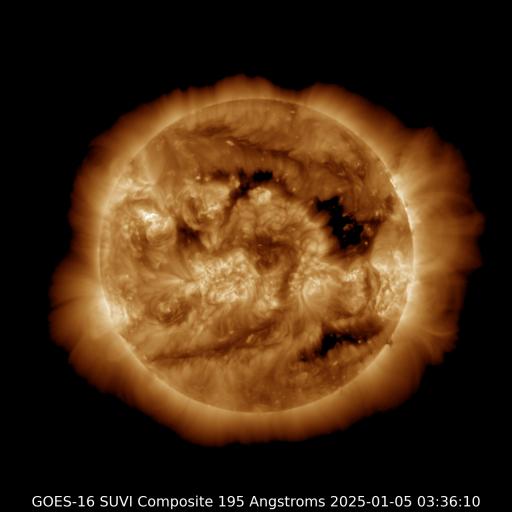Viewing archive of Tuesday, 1 March 2011
Solar activity report
Any mentioned solar flare in this report has a scaling factor applied by the Space Weather Prediction Center (SWPC). Because of the SWPC scaling factor, solar flares are reported as 42% smaller than for the science quality data. The scaling factor has been removed from our archived solar flare data to reflect the true physical units.
Report of Solar-Geophysical Activity 2011 Mar 01 2200 UTCPrepared by the NOAA © SWPC and processed by SpaceWeatherLive.com
Joint USAF/NOAA Report of Solar and Geophysical Activity
SDF Number 060 Issued at 2200Z on 01 Mar 2011IA. Analysis of Solar Active Regions and Activity from 28-2100Z to 01-2100Z
Solar activity has been low. Occasional C-class x-ray
flares occurred throughout the period, the largest of which was a
C6/Sf at 01/0413Z from Region 1164 (N25E19). This region grew in
size and magnetic complexity, ending the period as an Ekc type with
Beta-Gamma-Delta magnetic characteristics. The remaining regions
were quiescent.
IB. Solar Activity Forecast
Solar activity is expected to be low,
with an increasing chance for an M-class x-ray flare from Region
1164.
IIA. Geophysical Activity Summary 28-2100Z to 01-2100Z
The geomagnetic field ranged from quiet to minor storm activity
levels during the period. Solar wind speed at the ACE spacecraft
began to rise from 310 km/s at approximately 01/0500Z and ended the
period near 500 km/s. The Bz component of the interplanetary
magnetic field turned south coincident with the increase in solar
wind speed, temperature, and density. These events suggest the
arrival of a corotating interaction region between 01/05-12Z in
advance of a coronal hole high speed stream. Bz averaged -10 nT
for several hours, bringing two periods of minor storm levels at
middle latitudes.
IIB. Geophysical Activity Forecast
The geomagnetic field is
expected to be predominantly unsettled with a chance for active
conditions over the next three days (2-4 March). A slight chance
for isolated minor storm periods exists on days one and two (2-3
March).
III. Event Probabilities 02 Mar to 04 Mar
| Class M | 35% | 35% | 35% |
| Class X | 05% | 05% | 05% |
| Proton | 05% | 05% | 05% |
| PCAF | Green | ||
IV. Penticton 10.7 cm Flux
Observed 01 Mar 111 Predicted 02 Mar-04 Mar 110/110/110 90 Day Mean 01 Mar 088
V. Geomagnetic A Indices
Observed Afr/Ap 28 Feb 002/003 Estimated Afr/Ap 01 Mar 019/025 Predicted Afr/Ap 02 Mar-04 Mar 015/015-015/015-012/012
VI. Geomagnetic Activity Probabilities 02 Mar to 04 Mar
| A. Middle Latitudes | |||
|---|---|---|---|
| Active | 30% | 30% | 20% |
| Minor storm | 15% | 15% | 10% |
| Major-severe storm | 01% | 01% | 01% |
| B. High Latitudes | |||
|---|---|---|---|
| Active | 40% | 40% | 30% |
| Minor storm | 20% | 20% | 15% |
| Major-severe storm | 05% | 05% | 05% |
All times in UTC
Current data suggests there is a slight possibility for aurora to appear at the following high latitude regions in the near future
Iqaluit, NUNuuk
Reykjavik
Latest news
Latest forum messages
Aurora photography hints for those of us with smartphones 65New satellites - Proba-3, PUNCH, SWFO-L1, GOES-U/19 46Incoming & Unnumbered Active Regions 1672AR4048 122AR 4054 19
More topicsSupport SpaceWeatherLive.com!
A lot of people come to SpaceWeatherLive to follow the Sun's activity or if there is aurora to be seen, but with more traffic comes higher server costs. Consider a donation if you enjoy SpaceWeatherLive so we can keep the website online!

Latest alerts
00:55 UTC - Coronal hole
A southern hemisphere coronal hole is facing Earth. Enhanced solar wind could arrive in ~3 days
Monday, 7 April 2025
20:45 UTC - Geomagnetic activity
Active geomagnetic conditions (Kp4) Threshold Reached: 20:39 UTC
17:33 UTC - Hemispheric Power Index
The OVATION model predicts the Hemispheric Power Index to reach 51GW at 18:18 UTC
Space weather facts
| Last X-flare | 2025/03/28 | X1.1 |
| Last M-flare | 2025/04/05 | M1.0 |
| Last geomagnetic storm | 2025/04/06 | Kp5 (G1) |
| Spotless days | |
|---|---|
| Last spotless day | 2022/06/08 |
| Monthly mean Sunspot Number | |
|---|---|
| March 2025 | 134.2 -20.4 |
| April 2025 | 148.7 +14.5 |
| Last 30 days | 134.1 -5.6 |




